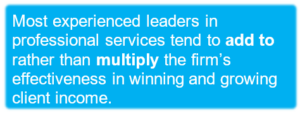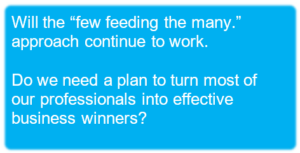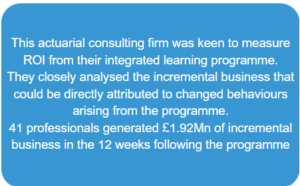Building performance in professional services
Meet the challenge of client growth
Professional services firms across a range of disciplines are looking for significant, sustainable, profitable organic growth. Delivering this profitable growth has never been easy and today is even more demanding.
This paper looks at some of the specific challenges facing those in professional service firms over and above those faced by more product-focussed businesses.
It also indicates some of the ways firms and individuals can achieve the success they seek.
While of course there is significant diversity across professional services. Although an architectural design practice, an actuarial firm, an audit team and a corporate law firm are different in many ways, they have much in common when it comes to business development.
Professional – led not sales-managed
It is clearly harder to instil the disciplines of sales process with professionals than with full-time salespeople in other sectors. The more individualistic, “opt-in” culture means that professionals need to be wooed, engaged and addressed flexibly rather than “told” and compelled.
Most experienced professionals see their role in client acquisition and development as leading from the front and being the prime point of contact for the client rather than being the sales coach and sales leader. They tend to add to rather than multiply the firm’s effectiveness in winning and growing client income.
Yet when sales management disciplines are instilled and followed the effect can be significant. Take this example of a group of professionals advising corporate clients.
“What has “improved sales performance” meant in practice? Business booked in 3 months following this change was equal to previous 5 months’ volumes. The pipeline grew at the same time, up from $200mn to $550mn. The practice’s fee income for the quarter was up by $750,000. With no significant changes in pricing or marketing, the leadership team attributes at least 40% of this improved result simply to the increased quantity and improved quality of 1:1s” (Head of HNW and UHNW clients)

Knowing it is not doing it
The intellectual strength of intelligent professionals can become a commercial weakness. Ideas are assimilated quickly but often understanding is equated with the ability to do. Any development needs to recognise the speed of thought (and often short attention span) of individuals while refusing to compromise on converting ideas into action. “If it’s so easy why aren’t you doing it?” When firms and individuals get this they make significant changes and they focus on experiential learning that changes behaviour. They put more resources into the implementation of change than into the acquisition of knowledge.
Billable hours and P&L
Every hour spent in personal or business development is potentially an hour stolen from fee earning.
Opportunity costs need to be recognised and accounted for. The business case needs to be made, but the billable hours argument cannot be allowed to become a tyranny.
Is the right amount of non-billable time available to professionals to grow the business in line with the firm’s goals?
Is this time recognised by the firm or do people need to“steal” time, hiding it as more “respectable activity”?
Are the right resources allocated to growth accounts?
Individual, Team, Firm
We heard of one instance where because a 3 month hiatus in billable hours the number 2 in a high growth relationship was taken off the account by his local practice leader so he could deliver more hours in another established account. The removal of this impressive individual’s expertise and impact at a key point in the sales process contributed to the loss of a strategic and highly profitable opportunity.
In another case an experienced professional who used local budget to travel to win a major firm-wide client was attacked by her practice leader for using resources that did not benefit the local practice enough.
It’s hard to have a clearly defined and well executed sales strategy when the firm’s priorities are in tension or conflict with regional, practice and personal priorities. It’s also hard to create the right consistency when individual preference and ingenuity always take precedence over consistent, disciplined methodologies.
Who should sell?
Most professions focus early-years development on the acquisition of technical skills. It is probably right and inevitable that accountants, lawyers and actuaries spend years acquiring knowledge and building expertise and delivery capability. It is then hoped that they will be able to make the change into intuitive and effective client handlers and developers. The hope is that a few rainmakers will emerge to keep the firm’s machine fed. But will the “few feeding the many” approach continue to work? Do we need a plan to turn most of our professionals into effective business winners? How should we make use of business development specialists? What is their role and status in the firm?

Short term vs. long term
“When we’re busy we don’t have time for business development and when we’re not busy it’s often too late to go out looking for it – we need the hours now” confesses one senior partner. Continuous client development is not easy but it is essential. “Feast and famine” is not a sustainable or healthy model.
One symptom of short-term thinking is that we focus on the business we have rather than the business we have not got. So-called “white space analysis” can be challenging, even painful but it produces results. One firm was congratulating themselves on the income from one of their biggest accounts. It was in their top 20 relationships by income. Then the lead partner challenged on two questions:
- “What share of their spend do we have today?”
- “What could their overall spend be in our areas of expertise if they started doing the things we believe they need to do?”
The team found that though the absolute income figure was high they only had a 4.4% share of the business. By re-framing their approach they took that share to over 30% and increased the income more than 10 times. This could only be achieved by looking beyond the short-term.
This short vs. long term tension is compounded by the areas of business that firms are driven to. For example: accountancy and legal firms focussed on financial institutions are finding good streams of business in regulatory compliance, risk and exposure but arguably their biggest long term rewards will come from advising on issues of competitiveness, restructure, sustainability and innovative growth. Is the short-term opportunity forcing you away from the areas that will really benefit your firm and your clients over the longer term?
Change is changing
Professional services firms have to function in a world that demands significant changes in business development.
We must grow business in a volatile, uncertain, complex ambiguous (VUCA) environment. We cannot sell as if the world will return to normal someday soon. Firms must achieve client growth in an environment where clients are in constant flux.
We must achieve growth in relatively flat economies. If the firm plans to grow more than the predicted growth of the economy then something different needs to be done. Increasing market share or share of wallet alone may not be enough. We probably need to find “white space”.
We must change in response to changes in the buying behaviours of clients. These changes include increased numbers involved in decision making (ave 6.2 people in a 100-500 employee business are involved in significant purchasing decisions (source CEB)); increased formality and the presence of procurement and digitisation of decision making. Hybrid is here to stay. We cannot afford to be analogue sellers in a digital buying world.
Sustainability has risen to the top of the business development agenda. We need to adapt our messenging and our methodologies to serve our clients well and grow our own business.
Finally, business development needs to change with the selling enablement tools now available. The judicious use of the right tools ensures competitive parity or even advantage.
Professional services face even more changes in their regulatory environment than most sectors. These changes drive significant developments in areas like fee generation, competition, client retention, fee reviews and positioning. In the light of legislative and regulatory changes, how are we adapting our approach to the new environment?
Differentiation
What will differentiate your firm from your competitors? We all believe we are different but our clients often find it hard to see the difference. We ourselves sometimes find it hard to articulate what makes us genuinely different. We may say “our people” or our creative methodology but we often look the same to the client. We may say we are “client focussed and relationship driven”. Do we think our competitors are positioning themselves as “self-centred product-pushers”?
What’s to be done?
These challenges and opportunities are real, significant and difficult to address; but the prizes from addressing them successfully are great.
Based on what we see firms working on effectively and based on strong but transferrable approaches used in other sectors we highlight the following areas to concentrate on:
Wide and strong business cases
All this is only worth doing if it will build sustainable profitability. When forming the business case consider not only share of today’s wallet but opportunity to grow overall spend. Focus on the “white space”. Measure the risk of not improving. How much profit is being “left on the table”? What impact will this have on the firm and its partners this year and beyond? What’s in it for all concerned? Make the case clearly and convincingly.
Be clear about where you are
Make sure you understand and agree where your people are before you start to make improvements. Then make sure that what you are looking to improve will really have a positive effect on your business. This will save money, time and reputation. As one business leader put it “We have based too many of our development decisions on guesswork and individual opinions. For the first time we are basing decisions on data and agreement.”
Use what you’ve got
Many of the firms we work with already have good tools and approaches in place. They do not always need to develop something brand new but to make better and more consistent use of the resources already available. Only use the new when you need to, but then use it boldly.
Innovative delivery
Deliver development using innovative approaches that make the most of peoples’ time. The use of approaches such as gamification, blended learning, bite-size modules, simulations, experiential learning and live case-based events can make a huge difference in optimising time and RoI. For example in a recent project with a firm of pensions trustees we had two 90 minute workshops supported by 15 minute individual coaching sessions to minimise time spent away from the client.
An example

Build implementation from the start
Implementation is particularly difficult for professional firms for the reasons we have outlined in this paper. This makes it all the more important that development focuses on ensuring people do things differently. Plan the implementation early on. It is much more cost- effective and produces a much better result to build it in rather than “retro-fit” it.
Consolidate and measure
Plan ways to ensure any changes become part of business as usual.
Measure the change and wherever possible document impact and Return on Investment.
Conclusions
We trust that this paper will have stimulated your thinking – confirming some points and challenging you to rethink in others.
If this paper has resonated with you then SalesFitness Group is well-positioned to debate, design and deliver with you.
Sales Wisdom is part of The Sales Fitness Group. The group provides an integrated approach to winning, growing and keeping clients. Sales Wisdom offers insights into the changing world of sales and helps clients diagnose and pinpoint areas for improvement.
